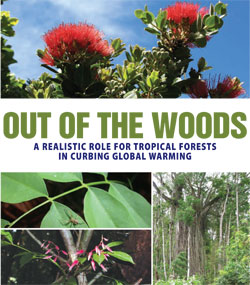A great deal of information is now available on an option that not only averts global warming’s worst consequences but also generates enormous co-benefits for biodiversity conservation and sustainable development. That option is reducing emissions from deforestation in developing countries (REDD). A review of the literature, combined with additional analyses of the data, shows that REDD could substantially decrease the severity of climate change.
Much information is available on the costs as well, and it shows that REDD is clearly an inexpensive approach compared with emissions reductions in the energy sectors of industrialized countries. The costs per ton of reducing current carbon dioxide emissions from deforestation by half—even with pessimistic assessments and including not only opportunity costs but also REDD’s implementation, transaction, administration, and stabilization costs—are less than a third of current (mid-2008) capped carbon market prices. Conservative estimates show that $5 billion in funding annually could reduce deforestation emissions in the year 2020 by over 20 percent; that $20 billion could reduce them by 50 percent; and $50 billion could result in a drop of 66 percent. The latter level of funding is equivalent to developed countries devoting just 0.13 percent of their annual GDP to REDD (the commitment made by Norway at the Bali convention in December 2007). Using the cost curves of the U.S. Lieberman-Warner bill to determine the potential emissions reductions from its market-linked funding, we estimate that the bill’s allocation of 2.5 percent of allowance revenues for REDD could reduce emissions in 2020 by an amount equal to 9 percent of the United States’ total emissions in 1990.
However, the development of a worldwide REDD system is likely to be held back considerably by political and institutional constraints. The skewed distribution of emissions from tropical deforestation, with just two countries (Indonesia and Brazil) accounting for almost half the emissions and the next 35 percent spread among 14 other countries, means that just a few can dramatically affect the potential of a REDD system by themselves. Data indicating the capacity and interest of these major tropical forest countries to participate in REDD show that only a small number of them are likely to do so immediately after 2012, when the next climate regime goes into effect, and the system is not likely to include three-fourths or more of deforestation emissions until 2020 or later. Thus the low cost of REDD does not mean it can contain the costs of international climate change mitigation over the short run. On the other hand, this reality also reduces the danger of the world carbon market soon being flooded with cheap REDD credits.
Estimates of “the cost of REDD” should not be expressed as single numbers (e.g., $X/ton of CO2) but rather as curves showing prices and total costs as functions of emissions reduction. These supply curves and cost curves reflect the important fact that price and cost increase nonlinearly with the amount of reduction achieved. Some of the variation in estimates of the economic potential of REDD is due to their applying to different percentage reductions in emissions, but there is still a considerable degree of unexplained variation. Twenty-nine regional empirical estimates give the lowest costs (mean of $2.51/tCO2), area-based estimates such as the Stern Review are intermediate, and global economic models predict the highest costs (and are therefore the most conservative with respect to potential).
Further analytic work can reconcile some of these differences. But there are other as-yet-unquantified factors that can render the potential of REDD either greater or smaller. Moreover, evaluation of whether REDD can be done efficiently—so as to realize its economic potential, as estimated by the models— will depend on actual implementation of national-scale programs. Nonetheless, REDD clearly can and should be a major element of the global effort to prevent warming of 2°C over pre-industrial temperatures, thereby reducing the likelihood of dangerous climate change.




